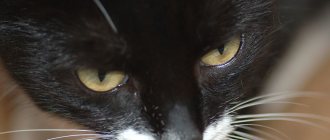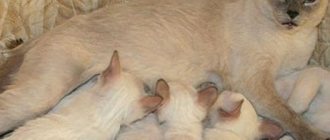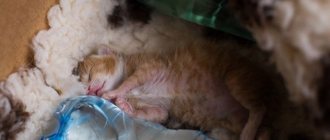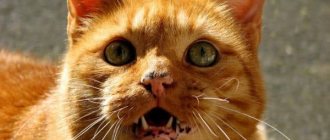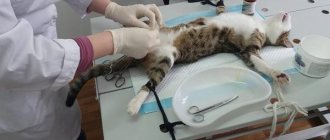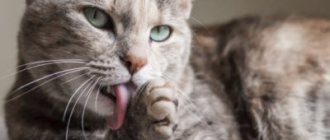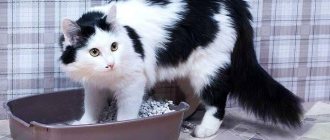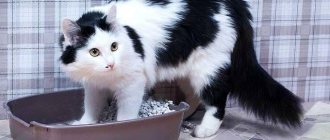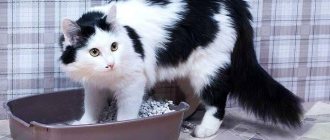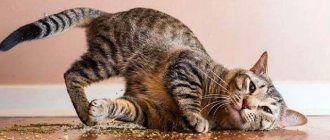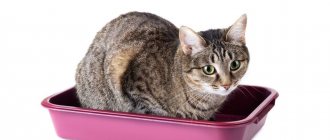What are vibrissae?
Contrary to popular belief, the whiskers on the faces of furry pets have nothing to do with decoration. They are endowed with exclusively applied, navigation functions. During evolution, many mammals acquired such a tool. This is especially true for animals living in conditions of limited visibility.
Vibrissae are part of the short-range orientation system
The word “vibrissae” comes from the Latin “vibro”, which means “wriggle”. This term refers to the receptors of the organs of touch.
Main characteristics:
- shape - straight or twisted;
- color - white or black;
- quantity - from 33 to 40;
- length - from 5 to 7 cm;
- location - underpads, chin, cheeks, eyelids, tail, ankles, paw pads.
In representatives of some breeds, for example, the Maine Coon, the length of the whiskers can reach 19 cm. In the Cornish Rex they are small and curled at the ends. Sphinxes are sometimes born without whiskers, which does not prevent them from orienting themselves in space.
Vibrissae structure
One of the distinctive features of tactile hairs is elasticity. This quality is achieved due to the conical narrowing of the vibrissae towards the end. They are rooted in the skin 3 times deeper than wool, which makes it possible to trigger the mechanism for transmitting information coming from outside to the brain. Each whisker has a separate “representation” in the brain, similar to the sense organs.
At the base of the vibrissa there is muscle tissue supplied with a large number of nerve endings. They are connected to a specific part of the brain. The vibration of the hair excites the root, and the impulse is instantly transmitted to the desired section.
Scientists claim that cats' whiskers give them a three-dimensional night vision. Unlike information obtained through hearing, smell or vision, whiskers contribute exclusively to short-range orientation.
Vibrissae help a cat learn about the world around it
Interesting Facts:
- vibrissae are denser than hair;
- controlled by different muscle groups;
- pick up the slightest air vibrations;
- are formed before the fur.
There is a version that hair and whiskers have different evolutionary origins. Tactile hairs appeared in the ancestors of mammals much earlier than wool.
Whiskers are sensitive to negative electrical charges that arise when stroking a cat against the grain.
General rules
You can work with the hair of some animal breeds with scissors.
To be safe, new haircuts for cats are done according to certain standards and recommendations. you should know who and how you can groom. It is allowed to cut a Persian cat and a pet with another long-haired breed using scissors, a mechanical hand or an electric machine. A Scotsman or a Briton can only be groomed with a machine, and scissors cannot be used to work with the hair of a Siamese cat. At the end of the process, the animal is bathed in warm water to remove small clipped hairs.
After the haircut, the cat should receive positive emotions in the form of a soothing, gentle stroking and tasty treats - this way the fright will go away faster. If the pet is shaved bald, the discomfort and anxiety will subside when the cat grows new fur 3-5 mm long, so that the animal does not attack its own tail, not perceiving it as its own, a brush is always left at the end.
Safety of the procedure
The absence of injuries is one of the main criteria for professional work. The fur is usually removed against the grain, but shaving the pet’s coat in the opposite direction is also acceptable, especially if these are small kittens or nervous adult purrs. Cutting hair according to hair growth makes it possible not to cause additional discomfort and stress to the animal.
Before treatment with a machine, the tummy is carefully trimmed with scissors, paying special attention to the area of the nipples so as not to damage them.
A special collar is necessary for animals that are prone to nervousness and aggression during grooming.
If the animal is nervous, put on a collar and groom without anesthesia. A pet wearing a collar does not see what is happening and is less nervous; besides, this way it will not be able to bite the hairdresser. Particularly aggressive patients are groomed with immobilization - the master's assistant firmly holds the cat by the paws and head, not allowing him to twitch and interfere with the process. If there are a large number of mats and it is necessary to completely cut off the fur, the “aggressor” must be groomed under anesthesia.
What disorders are associated with loss of mustache?
The sudden loss of a large number of mustaches is associated with the development of the following diseases:
- vitamin deficiency (lack of vitamin A, D and some microelements in the pet’s body);
- diseases of the thyroid gland (hypothyroidism, hyperthyroidism);
- diabetes;
- allergic reaction to food or certain substances;
- metabolic disease;
- skin diseases.
If a cat loses a significant number of its whiskers by the roots, it must be shown to a veterinarian. Self-medication will worsen your pet's condition.
Why do antennae fall out or break, is this normal?
Even though the structure of a mustache is different from that of regular hair, it can also fall out and break.
Vibrissae have their own lifespan, and after its expiration they leave the follicles. When you see 1-2 fallen antennae, there is no need to sound the alarm, but if there are a lot of them, you need to look for the cause. Often, excessive fragility and loss of whiskers are associated with stress, dehydration or an unbalanced diet that does not provide the animal with the necessary vitamins and minerals, collagen. In this case, the quality of the coat deteriorates, it becomes dull and falls out.
The causes of hair loss can be pathologies that lead to disruption of the hair follicles and their death:
- Fungal diseases. If the lesion covers the area of the whiskers, they begin to fall out along with the hair. The problem area is itchy and itchy.
- Skin diseases, including those of an allergic nature (ringworm, demodicosis, atopic dermatitis). Hair loss and vibrissae provoke inflammation and irritation of the skin.
- Parasites. The condition of the coat and whiskers can worsen both due to helminthic infestation (due to metabolic disorders) and when infected with fleas or ticks, the bites of which force the cat to scratch the skin vigorously.
- Endocrine diseases - diabetes, hypothyroidism (decreased thyroid function). The fur becomes matted, takes on an unkempt appearance and falls out.
- Folliculitis is inflammation of the follicles caused by bacteria, fungi or viruses.
Does a mustache grow?
Whiskers that are lost, trimmed, or otherwise damaged will grow back in their original location. A completely lost mustache usually grows back within a few weeks. If your cat has had severe hair follicle trauma, the lost whiskers may never grow back, but this is quite rare.
Whiskers do not grow slower or faster depending on the cat's age, but at approximately the same rate throughout the cat's life.
The length of the whiskers is determined genetically, and once they reach a certain length, they will stop growing and will remain approximately the same length throughout your cat's life. The mustache does not grow indefinitely, so it does not need to be trimmed or trimmed.
Why cats shouldn't have their whiskers trimmed
Without the fan of hair on a cat's face, the life of furry creatures would be much more difficult. Ethologists have proven that vibrissae are necessary for domestic animals for a number of reasons:
Help cats find food.
Pets are hunters by nature. But they track prey not only visually and by smell. Thanks to their whiskers, they are capable of tactile senses, which allows animals to react to various movements of the prey they are waiting for.
After finishing a hunt for a mouse, for example, a cat, by running its whiskers over its body, checks in this way whether the food it has caught is alive. Intuitively, animals feel that they should not swallow their prey alive. And rightly so: such a maneuver threatens the pet with the formation of microcracks in the oral cavity and the introduction of infection into the body through them. Consequently, vibrissae are useful not only when searching for and catching “live food” - they can be used to check food for safety. By the way, if a cat immediately touches the caught victim with its paw, neglecting its whiskers, it means that they have fallen out or are damaged.
What happens if you cut a cat's whiskers?
If you trim a cat's whiskers and eyebrows with scissors or clip them, the pet will experience severe stress and may become disoriented in space: huddle in the far corner of the room, lose appetite and interest in outdoor games. Therefore, you cannot trim or shave your mustache for the sake of hygiene or aesthetics. And if the animal is still left without whiskers, for example, after a fight for territory or playing with children, watch it extremely carefully.
There will be no changes in coordination and gait. The animal will retain its natural agility in daylight, but will feel unsteady at night.
If the cat has lost its whiskers
Sometimes this is a necessary measure. For example, if surgery is required, the veterinarian will have to shave the fur together and whiskers to treat the entire area. This procedure is extremely painful for cats. This is another reason why cats should not have their whiskers trimmed.
The owners confirm that in this case the pet is literally replaced. His emotional background changes, the cat is in a bad mood. This is not surprising; her spatial orientation is impaired, and her brain is not yet accustomed to the changes.
How to spend less gasoline by planning your route correctly?
Often, from year to year, motorists persistently follow the established habit and drive from home to work or to other objects strictly along the same route, not realizing that they can choose a different route that will be less congested with vehicles, on which there will be fewer traffic lights and , after all, which will be shorter in distance. Choosing the optimal route among the possible ones will save gasoline. A navigator or a special program installed on your phone (2GIS, Google Maps or some other) will help you solve the problem of choosing the optimal route. You can also find out which road there is a traffic jam on at the moment, so as not to burn fuel in vain trying to drive along it, from other drivers, for example, by using a car radio.
What happens if you cut off an animal's mustache and eyebrows?
The role of whiskers in the life of cats is great, so if they are trimmed, they will at least experience discomfort. According to research, animals without whiskers have poorer spatial orientation because their brains lack information about the world around them. Cats begin to bump into objects and get stuck in narrow holes. During jumps, they often fall, not reaching the desired object or missing. Street animals especially suffer from the loss of whiskers - they cannot fully hunt, experience problems with food, and are often injured.
Different cats react differently to damage to the whiskers: the behavior of some is not particularly different from usual, others feel extremely insecure without them, become more withdrawn and nervous, move less, and their mental state worsens. A cat without a whisker loses coordination, so you should be careful and not let a whiskered animal out of the house to avoid injury.
Vibrissae structure
The roots of the mustache are located deep in the tissues. They are equipped with nerve endings. The information received is sent to the brain and changes the animal’s behavior.
The largest part is located on the muzzle in four rows. On average there are 24 of them. The length of each reaches approximately 6-7 cm. For individual breeds, the value can vary significantly up or down.
The Guinness Book of Records has recorded the longest 19-centimeter mustache on a representative of the Maine Coon breed.
Outbred cats turn out to be better hunters the longer their whiskers are. It has been noticed that skinny cats have thinner hair than well-fed ones.
In addition to the cheeks, vibrissae are located on the chin, above the eyes, on the tail and paws. They are much shorter, but have the same purpose.
An effective method to immobilize a cat
The process of immobilizing young healthy cats includes the following steps:
- Attaching the clip to the cat's scruff. You need to select a clothespin or clip approximately 5 cm in size and place the device on the withers directly behind the ears. Each owner can choose what exactly to pinch the scruff of the neck on their own. You need to look at the cat’s reaction to see what suits him best. If a paper clip puts too much pressure on the skin, the cat will not tolerate the pain.
- It is necessary to place the pet on its side. Since the cat relaxes too much after the clamp, he may involuntarily fall on his own. If this does not happen, you can gently press on the hind legs to remove resistance. You can tell that the cat is completely relaxed by his behavior. He tends to pull the lamps towards his muzzle, curls up into a ball, and places his tail between his paws. If the cat cannot be laid on its side, it continues to stubbornly stand on its feet and tucks its tail, which means it is not calm and is very scared.
- Using additional clothespins. The reception will help to completely relax the animal. To do this, several clamps must be placed a little further than the first one on the back of the neck along the spine. If the cat starts to get violent, then all the clamps need to be removed.
- Also, the method of placing a clothespin anywhere along the back along the spine may work for some cats, but greater effect can only be achieved when placed on the neck.
- After a few minutes, the clothespins need to be removed. However, the duration of the resulting peace of mind is sometimes completely unpredictable and is determined on an individual basis. Some cats are immobilized during the entire grooming and nail trimming procedure, while in other cases the animal can be deactivated for a short period of time.
According to veterinarians, clothespins cannot cause harm to the skin. But after some time, the cat may begin to show dissatisfaction; there is no need to shock the cat for a long time.
When keeping pets, there is often a need to perform certain procedures that require their immobility. If this is a cat, then he needs to trim his claws, get a haircut, perform medical procedures, for example, give injections
With all these procedures, it is important to know how to immobilize a cat correctly. After all, they are all stressful for the animal, which means it can behave completely unpredictably, injuring both itself and those around it.
To keep the cat from moving, it is not necessary to use sedatives or other tranquilizers; you can get by with another working method.
Consequences of loss
The consequences of trimming cats' whiskers can be very varied and depend on whether the animal is a pet or an outdoor one, as well as on individual characteristics. The most difficult situation for the lack of their sensory sensors is street cats who are forced to get their food in the wild. Without whiskers, it will be difficult for backyard predators to track their prey and hunt successfully.
What happens if a cat's whiskers are trimmed depends on the individual sensitivity of a particular pet. At first, some animals may lose the ability to navigate normally in the surrounding space.
There are cases where cats deprived of whiskers could not walk in a straight line for a certain time, fell and lost orientation in space. This failure in the animal’s navigation system is due to a sharp lack of signals about the environment entering the brain.
Of course, such extreme manifestations are not typical for all animals. Most often, the loss of whiskers leads to the fact that it is more difficult for a pet to make accurate jumps and navigate in the dark. Without whiskers, a cat more often stumbles upon obstacles and does not navigate in an unfamiliar environment.
Veterinary experts under no circumstances advise owners to trim or trim their animal's whiskers. Such manipulation can lead to stress, fearfulness, and inappropriate behavior. Some especially sensitive pets have a hard time coping with the loss of their whiskers: they become withdrawn and become non-communicative. Cats sleep for a long time and stop leading an active lifestyle.
To see what happens if you cut a cat's whiskers, watch this video:
Why does a cat need a mustache?
In addition to good eyesight, a keen sense of smell and excellent hearing, nature has endowed representatives of the feline family with a specific organ - the whiskers. Whiskers or vibrissae in cats are coarse hairs that have a tactile function. Their bases, located in the superficial layers of the skin, are connected with a huge number of nerve endings. The impulse received from the whiskers is transmitted to special centers of the animal’s brain, where they are identified.
The slightest vibrational movements of air do not go unnoticed by the furry couch potato.
You can understand what will happen if you cut off a cat’s whiskers only if you have an idea of the diversity of their roles for animals. Zoologists note the following functions that they perform in domestic cats:
- Orientation in the surrounding space. Receiving reflective impulses from objects and walls, cats are well oriented even in unfamiliar surroundings. By analyzing changes in air flow, the animal receives information about the obstacle in its path.
This function is of no small importance when moving in the dark or hunting. When a pet ages and vision deteriorates, the whiskers help the elderly cat navigate and allow it to move without bumping into objects.
- The cat's whiskers also help when jumping. With their help, the distance to a particular object is determined, the trajectory and force of the jump are calculated. Vibrissae help furry fidgets make precise jumps over various distances, successfully hunt and avoid encounters with enemies.
- Being a kind of sensor of the vestibular apparatus, the vibrissae are involved in maintaining the balance of the animal when walking, jumping, and running.
- Whiskers are indispensable assistants in successful hunting of furry predators . The senses of touch help determine the direction and speed of the wind. With the help of its whiskers, the animal senses where the prey is moving in almost complete darkness.
- With the help of its whiskers, a cat can determine not only the distance, but also the depth of a particular hole . Having received reflective impulses from the walls, the animal can understand whether it will fit into this hole or not.
- Vibrissae help the cat determine the temperature of food and water and speed up the search for food resources.
What and why
It’s not for nothing that even in fairy tales it was emphasized: mustachioed and striped. Gorgeous long whiskers are a source of pride for a cat, and often for its owners. Yes, nature gave them for a reason. Let's first look at why a cat needs a mustache. In addition to their decorative function, they are also an organ of smell. They even have a second name, which is rarely mentioned in everyday life.
Does the cat not grow whiskers?
There are times when it is still worth worrying. The cat's whiskers have fallen out, or the cat's whiskers are turning black, or new ones are not growing? Perhaps the whole reason is parasites or a lack of collagen or vitamin A. In addition, a worse option is possible, if your cat likes to walk, the whiskers may simply not “grow”, but are constantly lost in fights (cats often also bite off whiskers from to sweep).
And, probably, the last options for why a cat’s whiskers fall out: in case of infection with a tick or lichen. The tick must be treated. And the deprivation must also be detected first: for this, the animal’s face must be illuminated with a special Voodoo lamp (the deprivation will glow an emerald color), or a scraping must be taken - in any case, you need to go to a veterinary clinic.
What happens if you trim your cat's whiskers?
Will it hurt a cat if its whiskers are trimmed? Not really. As mentioned, the whiskers are similar to other hairs on a cat's body. The only difference is that they are thicker and perform a different function.
There are no nerves around the cat's whiskers, so there is no risk of bleeding or pain. However, if you trim a cat's whiskers, the cat finds itself in a situation where it loses the ability to correctly navigate in space.
This means that by cutting off a cat's whiskers, you are depriving the animal of the ability to perceive anything due to its poor eyesight. If you trim your cat's whiskers, your pet will not be able to distinguish between objects that are close or far away. In addition, the opportunity to find out whether the movement in space is proceeding correctly will be lost, so the cat will become somewhat clumsy.
And due to the lack of natural abilities, the cat whose whiskers have been trimmed becomes nervous from tension. Therefore, taking into account all the above information, under no circumstances is it recommended to trim the whiskers of cats.
Why do cats have whiskers?
A cat's whiskers act as an important sensory tool for cats, which they use for a variety of purposes.
All cats have excellent night vision, but they have difficulty seeing nearby objects. Their whiskers serve as a tool for detecting nearby objects that are too close to be seen well. Second, a cat's whiskers are so sensitive that they can detect small changes in air flow that may indicate nearby animals or predators.
The whisker has several other functions, such as triggering reflexes, a navigation tool in the dark, or measuring the width of a narrow space or entrance. They also help them climb and determine the distance to their prey. You see, whiskers are truly a cat's sixth sense.
The necessity of cat whiskers and what they are scientifically called
Why do cats need whiskers? Whiskers are a sensitive organ of touch for cats.
With the help of its whiskers, the animal navigates space, studies surrounding objects and finds prey.
This organ acts as a collector of information that it transmits to the brain.
Areas of the body where the mustache is located:
- On both sides of the nose.
- Above the eyes.
- On the sides of the head.
- On the ankles of the front paws.
- On the tail.
In total, the animal has from 30 to 35 whiskers with an average length of 5-6 cm. The largest number of them is located on the head.
With the help of whiskers, a cat controls the prey when it holds it in its teeth
The scientific name for animal whiskers is vibrissae. The word comes from the Latin vibrissae, which means to oscillate, to wriggle.
Features of the structure of whiskers in cats and cats
There are no differences in the structure of the vibrissae in cats and male cats. This organ is not related to the gender of the animal and performs the same functions. The difference may be slight in length and thickness. But this is determined solely by genetics.
Locations
There is a common belief that cats have whiskers only on their faces. Long, thick hairs have been seen and known by everyone here. They are located:
- around the nose;
- on the lip pads;
- above the eyes;
- on the lower jaw, more precisely, on the chin.
But there are the same ones on the front legs. True, they are not so noticeable. But just look closely at the paw just above the place where the dewclaw is located, and you can easily spot them.
Vibrissae are located not only on the face, but also on the cat’s paws
Length
The length of the whiskers on a cat's face is on average 5–7 cm. But in this matter, much depends on the breed. So, the owners of the longest mustaches are Maine Coons. Their whiskers add incredible charm to their already charismatic appearance. In sphinxes, on the contrary, the vibrissae are very short, and often also curled. The owners of curly mustaches are cats that carry the Rex gene. The name of these breeds contains the prefix “Rex”. For example: Cornish Rex, Devon Rex and others.
The length of the whiskers is also determined by the cat’s nutrition. If it is balanced, the mustache will be truly luxurious.
There is a popular belief that the longer a cat's whiskers, the more mice he catches. So our ancestors considered this relationship.
Thickness
The thickness of the whiskers varies only by gender: cats have thicker whiskers than cats. You can also identify differences by location:
- the mustache on the cheeks is much thicker than above the eyes;
- on the front legs the vibrissae are only slightly ahead in thickness of the animal's guard hairs.
In general, the thickness of the vibrissae is explained by the fact that the place where each hair grows is rich in nerve endings. And if you consider that their number is quite large, then it becomes clear why the vibrissae has a tubercle at the base.
Other structural features
The vibrissae themselves are already a very mysterious organ. Each hair has a connection with its own part of the brain and is responsible only for a specific function. Therefore, if a cat loses one of its antennae, it temporarily experiences problems in hunting, coordination, touch, etc.
Each antennae is equipped with nerve endings and has its own “representation” in the brain
Mustache problems and their causes
As they grow older, the vibrissae break off and fall out. It's quite normal. In all other situations, it is important to timely determine the causes of this phenomenon and take appropriate measures.
Why does a cat's whiskers fall out?
If you notice that there are much fewer antennae on the face than there were before, there is reason to think about the root cause of this phenomenon. Here are the most popular:
- Lack of vitamins. It leads to partial loss of hair and whiskers.
- Self-renewal. This process lasts a lifetime and is considered normal.
- Age. With aging, the number of vibrissae may decrease.
- Development of diseases. Some diseases may cause them to fall out or break off.
- Various damages. This can happen accidentally during a fight or active leisure time.
Females that have given birth usually gnaw off the antennae of their kittens. This protects them from moving too far from their mother, and, therefore, reduces the likelihood of them getting into dangerous situations.
If you begin to observe loss of vibrissae, do not immediately panic. Contact your veterinarian for advice. He will find out the cause and prescribe appropriate treatment if necessary.
Barbel
Why do mustaches break?
Factors influencing their loss also contribute to increased fragility. In addition to them, the following reaction to external circumstances is likely to occur:
- The indoor air is too dry. This is especially true in winter, since heating devices dry it out greatly.
- Excessive bathing, as well as the use of poor quality shampoos.
- Hormonal changes during adolescence.
- Not drinking enough. Fresh and clean water should always be freely available. Refusal or excessive use of it signals the need to contact a clinic for specialist advice.
In addition, problems sometimes arise due to an unbalanced diet. In this case, the mustache loses its elasticity. This can manifest itself both with natural food and with the consumption of ready-made food.
Now you know why a cat needs a mustache. Monitoring them will allow you to notice changes in your pet’s health in time.
Is it possible to remove cats' whiskers?
It often happens that cat owners, out of ignorance or “for the sake of beauty,” remove their pet’s whiskers. Sometimes a small child performs this action for fun, playing with the “kitty” and deciding to trim its mustache.
Doing this without a veterinarian’s prescription is strictly prohibited (the previous paragraph describes in detail what happens to a cat that has lost tactile hairs). Sometimes, due to any injuries or wounds, a cat's whiskers are deliberately removed at a veterinary clinic . But they do this only if the vibrissae are located directly on the affected area. In other situations, veterinarians never trim a cat’s whiskers and do not recommend that its owners do so.
Do whiskers break and why does a cat need whiskers?
The most harmless case is genetic predisposition. A cat's whiskers break on their own, for example, in sphinxes.
Does your cat's whiskers sometimes become soft and brittle? This is a sure sign of a lack of vitamins - vitamin deficiency. It is worth reviewing your pet’s diet or changing food. It is also possible to add some special vitamins, which your veterinary clinic can help you choose. The most unpleasant thing that can happen to a cat is that it gets worms.
If a kitten’s whiskers break, you should worry a little more, because the baby is still a growing organism. All that can be done in this situation is to add more vitamins to the kitten’s menu: a spoonful of vegetable oil in the porridge, a little cottage cheese at night or a little milk in the morning. Or change the dry ration in favor of something more enriched with minerals and everything necessary.
Differences from animal hairs
There are physiological characteristics. The vibrissae are planted very deep into the skin; these are not ordinary hairs at all. Each whisker is an antenna that is surrounded by nerve cells. This is necessary to transmit signals directly to the brain center. But that is not all. Vibrissae are equipped with muscle fibers. That is, it is not hair at all, but rather complex receptors. In fact, they are responsible for the sense of smell, they just changed during evolution. The longest and most sensitive mustaches are located on top, shorter ones can be seen in the chin area. Remember that cats hunt at night, they need to quickly and silently find and catch a rodent. It is thanks to the whiskers that a cat can feel an object without contacting it and avoid colliding with an obstacle. What happens if you cut a cat's whiskers? He will lose a huge flow of information. Of course, this is not fatal at home, but it affects the well-being of the pet.
Why does a cat need a mustache?
A kitten without a whisker loses orientation in space
Vibrissae are the sixth sense organ directly connected to the brain. With their help, life is regulated: from touch to communication with furry fellows. If you don’t know why cats absolutely cannot have their whiskers cut, you can seriously harm them. Whiskers are not ordinary fur, and their loss deprives the pet of the opportunity to safely walk down the street, explore unfamiliar types of food, or hunt.
A kitten without whiskers loses orientation in space Vibrissae are multifunctional devices designed by nature as an additional sensory organ. They help cats hunt. A running mouse creates air vibrations that are instantly picked up by a small predator. The pet determines:
- the exact location of your victim;
- her condition;
- the point to which the enemy moves.
After capturing the mouse, the hairs growing on the cat's front paws come to the rescue. With their help, she controls the behavior of the victim, assesses the situation, determines the location and strength of resistance of the rodent or bird.
When communicating with fellow creatures, the mustache plays a big role. An animal’s reaction to the appearance of an unfamiliar individual or person can be determined by the position of its whiskers:
- If they are aimed at the subject of study, then the pet is interested in communication, it emanates friendliness.
- If they are pressed together with the ears, then attempts to pet the cat will lead to scratches, bites and the rapid disappearance of an aggressive animal.
Important! Vibrissae are the first to form during the embryonic development of babies. They help the newborn quickly establish contact with the outside world and identify his mother and brothers.
It’s better not to even think about what will happen if a newborn cat’s whiskers are trimmed. You should not do this, because until they are restored the baby will be deaf and blind and will be afraid to move.
Difference from hairs
The physiological characteristics of vibrissae include their deep insertion into the skin. Each of the antennae is a kind of antenna, surrounded by many nerve endings. They are used to transmit received signals to the brain center.
Vibrissae are complex receptors equipped with muscle fibers. They are responsible for the sense of touch, and their appearance is associated with evolutionary changes in the furry pet’s body. The longest ones are located on top, the shortest ones are located in the chin area. The main help of sensitive antennas is the ability to quickly and silently hunt birds and rodents at night.
Whiskers help cats hunt
Important! By the whiskers you can evaluate the cat's next action. Splayed out - intended to intimidate the enemy, directed in the opposite direction - indicate anxiety and uncertainty of the pet.
Sensitivity
Resourcefulness and cunning are important character traits not only of an adult, but also of a small kitten. If you cut a cat's whiskers, what will happen to it:
- sensitivity to possible danger will decrease;
- the definition of the road will be lost in complete darkness;
- the reaction to environmental changes will disappear.
Touch is one of the important functions of vibrissae. With its help, pets will find out the safety of the food offered and its freshness. In pitch darkness, the animal easily avoids objects standing in the way by touching them with its whiskers. In some cases, direct contact is not necessary: due to the mobility and vibration of hard hairs, air vibrations are created, the reflection of which from foreign objects is caught by the vibrissae. After transmitting the signal to the brain center, the cat receives a three-dimensional image of space.
If a cat's whiskers are cut off, what will happen to it during a chase:
- she will not be able to determine the diameter of the hole she is going to crawl into;
- may get stuck in it;
- she will not be able to hide from her pursuer.
Important! Veterinarians have noticed that the loss of sensitive hairs for various reasons leads to the development of neuropsychiatric disorders in furry pets. They lose the skills to receive and process information, become defenseless, and behave inappropriately.
Why you can't trim your mustache and eyebrows
Trimming a cat's whiskers and eyebrows is strictly contraindicated. This makes their existence very difficult. Vibrissae are one of the main organs of the cat family and serve as tactile and olfactory receptors. In some animals, the hairs may fall off on their own for a variety of reasons, but then they grow back. However, specially cut hairs cause significant discomfort to the pet.
Cats should not have their hair cut because it will negatively affect their health. The pet will not lose its sense of touch or smell, but spatial orientation will deteriorate significantly. Instead of lost or cut whiskers, new ones will grow in the cat only after 3 months. This is a very long period of time, so cats should not have their whiskers trimmed.
Damaged whiskers deprive the cat of adequate perception of the surrounding world
What problems will a cat have to face if its whiskers are trimmed?
- there is a decrease in jumping ability as a result of a deterioration in the computational function, the pet jumps or does not jump to the desired goal;
- there is a loss of the ability to accurately measure objects or distances, the cat may suddenly get stuck or fall;
- changes in behavior are observed, the animal becomes inactive, timid, and sometimes aggressive;
- the risks of injury increase, for example, a cat may lose an eye or injure its skin without noticing the threat in time due to the lack of whiskers;
- a certain disorientation develops, due to which the animal is often injured at night, gets hit by cars, and is unable to escape from the dog in time.
In most cases, while the cat's cut hairs grow back, she leads a recumbent lifestyle and loses her appetite. As a result, the fur becomes faded and loses its color. The pet stops catching mice, does not react to birds and live fish, and begins to go to the toilet in the wrong places.
Further care for the animal if its whiskers have been cut off
Do lost whiskers grow back in cats: even after trimming the hairs on the eyebrows and chin, they will be restored in 14-21 days. There are no special means to accelerate their growth - doctors advise using multivitamin complexes specifically designed for animals. They allow hairs to grow faster and become thicker.
Natural recovery will occur provided that no damage to the hair follicle occurred at the time of loss of the mustache. Animal care includes:
- protecting it from hot objects: fireplaces, gas and electric stoves, candles;
- using a special cap will help reduce the risk of head injuries;
- if a pet is placed in a cage for a while, then it will not be able to accidentally harm itself;
- an injured animal should not be allowed out into the street - there it can get under the wheels of a car, fall from a height, crash and damage not only its paws, but also its head.
Each new haircut of the whiskers will cause aggression in the pet towards its tormentor. If there are children in the house, then they immediately need to be explained why there are hard hairs on the cat’s body and what the risk of losing them is.
Trimming whiskers will not make a cat look beautiful; they play a big role in choosing a partner and communicating with familiar and unfamiliar relatives. Having lost their sixth sense organ, animals cannot hunt or move through previously unexplored places. Nature has protected furry pets, but it will take a long time to recover from the loss, during which time they can suffer seriously. Any stressful situation does not pass without a trace, then you should not be surprised at an animal that is aggressively opposed to its own owners.
Long, stiff whiskers give the cat a sense of respectability, and for the owner it becomes another reason to be proud of his pet in front of his friends. Why do cats really need them, and why can their condition be evidence of excellent health or a reason to contact a veterinarian? It's all about physiology - they perform olfactory and tactile functions, so the answer to the question whether a cat can have its whiskers trimmed will be negative.
Symptoms of acne in cats on the chin
Many cats first develop a slightly dirty chin, covered in small black spots between the hair follicles. Sometimes, symptoms in cats are limited to just this manifestation. In other cases, it may begin to progress into swollen, red lumps that begin to rupture and bleed.
If the problem continues to progress, it is likely that the follicles may become infected with Staphylococcus aureus. This is a fairly common bacterial infection that can usually be found on the surface of the skin. This complication is called bacterial folliculitis. This serious skin infection requires more aggressive treatment. Folliculitis can also lead to secondary fungal infections if not treated properly.
Preventative measures to prevent mustache loss
When a cat's whiskers fall out, why this happened is the first thing that should interest the owner who loves his four-legged friend. He must do everything to prevent the loss of one of the main elements of the cat's body. Firstly, at the first manifestations of hair loss, you need to find out the cause and carry out the correct treatment. A veterinarian's examination and prescription will help with this. Preventive measures against vibris loss consist of the following:
- regular treatment of the animal for helminths and parasites;
- development of a suitable diet, including vitamins and microelements;
- eliminating possible allergens from the cat’s life;
- timely vaccination against diseases and infections;
- preventive visits to the veterinary clinic;
- keeping the animal and its habitat clean;
- carrying out hygiene procedures as necessary using suitable detergents;
- excluding self-medication.
Timely vaccination against diseases and infections
If you follow all the rules and make sure that the animal is not in conditions that are dangerous for it, you can minimize whisker loss. Remember that under no circumstances should a cat's whiskers be trimmed unless medically required. Also stop the habit of pulling your pet's whiskers, this causes him great discomfort.
